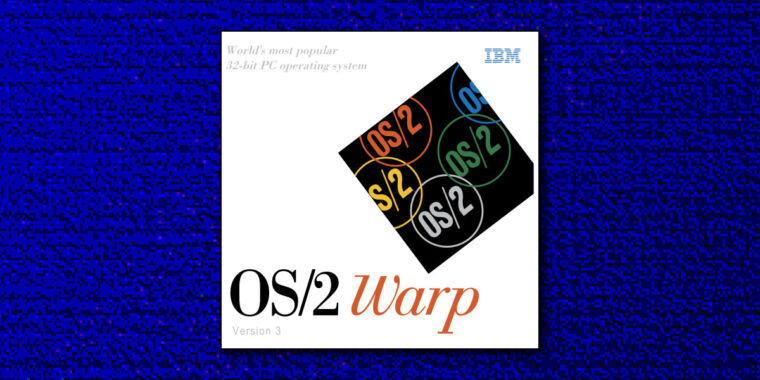I started my computing career with OS/2 . I am downloading the full archive now and I hope to make it available on Mega by the end of the week.
I’ll try to set up a torrent seed while I am at it too.
EDIT: Here is the Mega link.
https://mega.nz/file/9xskkYQI#USRixlFLzyUVjURDxgR-p6lVogAZiHP3RdczFAYY3p8
It’s already on the Internet Archive:
deleted by creator
Realistically, could I help seed it from my phone?
I’ve not used torrent since playing with it a bit a couple of decades ago, so I’ve no idea where to start. But if it’s practical and works well the concept is very appealing.
I have a no log VPN and I’m running Firefox with ublock origin and privacy Badger. I’m also thinking of running Mullvad DNS on my router but currently use Open DNS.
I would do this from home where I have fttp, not asynchronous but it’s about 70 up. That could change though.
I do have a laptop but I try not to use Windows, Android is much better for me. Having my phone start torrent activity when I get home would be a fantastic resource for me while also giving back via seeding.
Any links or advice you can give would be very kind of you, and I’d like to repost if there’s better places for this kind of enquiry.
I wouldn’t recommend a phone. It would kill your battery, and speeds would be terrible. Find an older computer or a beat up laptop and install qbittorrent on it. You might also need to forward the port.
To allow multiple simultaneous connections over the network, computers use these things called ports, which are numbers used to identify the connection. When the operating system sees that a network packet has arrived, it looks at the port and then forwards the packet to the right application.
Routers create a local network that is isolated from the outside, and all the traffic that goes to or comes from the internet, goes through the router.
If someone wants to connect to you, they have to go through the router. By default, routers will just refuse any connection coming from the outside. They do allow connections from the inside going out. Note that after the connection is established, communication can be bidirectional. Think of it like a social network where you need to be friends with someone to chat. Establishing a connection is like sending a friend request.
Port forwarding basically means telling your router “if someone tries to connect to you on port XXXX, forward those connections to port YYYY on computer ZZZZ”.
deleted by creator
This is fantastic, thank you so much!
I guess for iOS, you have to sideload, bit there is a transmission app. You can sideload using altStore, jailbreak (I think there is a .deb, else you have to use a IPA installer) or using a service that has enterprise certificate in order to sign and install apps.
The mega link is up.
https://mega.nz/file/9xskkYQI#USRixlFLzyUVjURDxgR-p6lVogAZiHP3RdczFAYY3p8
Mega link in the meantime.
https://mega.nz/file/9xskkYQI#USRixlFLzyUVjURDxgR-p6lVogAZiHP3RdczFAYY3p8
If you post the magnet link I will put it on a seedbox and forget about it for a while ^^
What’s a magnet link?
A short string used to identify files shared via P2P software. You paste it into a Bittorrent client and it’ll then try and piece the file together from other users who have done the same thing.
As an example, here’s one for Warzone 2100, an excellent free open-source real-time strategy game:
magnet:?xt=urn:btih:80e5f0b142306e3b5660990c45d6406a5a259a9c&dn=warzone2100_win_x64_installer.exe&tr=udp%3A%2F%2Ftracker.opentrackr.org%3A1337%2Fannounce&tr=udp%3A%2F%2Ffosstorrents.com%3A6969%2Fannounce&tr=http%3A%2F%2Ffosstorrents.com%3A6969%2Fannounce&tr=udp%3A%2F%2Ftracker.openbittorrent.com%3A6969%2Fannounce&tr=http%3A%2F%2Ftracker.openbittorrent.com%3A80%2Fannounce&tr=udp%3A%2F%2Ftracker.torrent.eu.org%3A451%2Fannounce&ws=https%3A%2F%2Fgithub.com%2FWarzone2100%2Fwarzone2100%2Freleases%2Fdownload%2F4.4.2%2Fwarzone2100_win_x64_installer.exe&ws=http%3A%2F%2Ffosstorrents.com%2Fdirect-links%2F%2Fwarzone2100%2F4.4.2%2Fwarzone2100_win_x64_installer.exe
That worked, thanks!
Mega link in the meantime.
https://mega.nz/file/9xskkYQI#USRixlFLzyUVjURDxgR-p6lVogAZiHP3RdczFAYY3p8
New Mexico State University (NMSU) recently announced the impending closure of its Hobbes OS/2 Archive on April 15, 2024.
Hope the Internet Archive can back it up, I guess.
IA is quickly becoming a massive, risky single point of failure that is one bad lawsuit away from causing a major problem.
I want to hope they have an exit strategy, but I’m thinking we need to start providing alternatives. A single backup is no backup at all, and all that.
You mean a lawsuit like the one about the “Great 78 Project” by the music companies or maybe the one about the “National Emergency Library” by the book publishers?
I think you’re right that we need to start working on alternatives, hopefully something decentralized. The Wayback Machine would be an irreplaceable loss though if the data isn’t preserved somehow.
Well, it’s not the lawsuit that would trigger it, it’s the outcome of it. So yes.
Yes on the other things, too. I can’t imagine they would be opposed to working with alternatives to provide Wayback Machine fallbacks.
The Wayback Machine in particular is one of the greatest treasures of the Internet. An absolutely invaluable tool and so far entirely irreplaceable.
Honestly, it should be a public resource.
I mean, public libraries and archives being a mandatory requirement for copyright enforcement and publishing records is a thing, and the Wayback Machine proves it’s technologically feasible to approximate it for the Internet, so…
This is the best summary I could come up with:
In a move that marks the end of an era, New Mexico State University (NMSU) recently announced the impending closure of its Hobbes OS/2 Archive on April 15, 2024.
For over three decades, the archive has been a key resource for users of the IBM OS/2 operating system and its successors, which once competed fiercely with Microsoft Windows.
The partnership between IBM and Microsoft dissolved after the success of Windows 3.0, leading to divergent paths in OS strategies for the two companies.
Through iterations like the Warp series, OS/2 established a key presence in niche markets that required high stability, such as ATMs and the New York subway system.
Today, its legacy continues in specialized applications and in newer versions (like eComStation) maintained by third-party vendors—despite being overshadowed in the broader market by Linux and Windows.
As the final shutdown approaches in April, the legacy of Hobbes is a reminder of the importance of preserving the digital heritage of software for future generations—so that decades from now, historians can look back and see how things got to where they are today.
The original article contains 726 words, the summary contains 181 words. Saved 75%. I’m a bot and I’m open source!
My first not embedded OS! Actually not… It wasn’t the hipster “warp”… Boy i am old 😅
Never seen an OS/2 computer in the wild unfortunately. How similar was it to Windows?
If you interacted with an ATM in the 90’s - 2000’s it was likely running OS/2. It was superior to windows, but lost in the end. Many of the concepts of the workplace shell were ahead of other DEs even today. KDE initiallly borrowed a lot from the wps.
Ars wrote a decent article about it a while back. I dug it up - https://arstechnica.com/information-technology/2019/11/half-an-operating-system-the-triumph-and-tragedy-of-os2/
It’s a fun read. The tl;dr: OS/2 had lots of features Windows didn’t, but IBM is notoriously bad at marketing, and failed to beat Microsoft in the public perception arena.
1.3 wasn’t really great, although it was used by a number of embedded systems such as ATMs and the like. Version 2.0 was actually quite good. It could typically run DOS and Windows software in addition to native stuff. I got one of the Wing Commander games to run on it.
Sadly, there were basically no native applications, so there was no point in switching from Windows. So it never took off.
For someone who has been on the internet for quite some time, that archive was one of the later ones 😃
Anybody remembering wsmr20.army.mil, especially accessing it through bitftp@pucc (yes, that was the complete address, no com or edu!).







